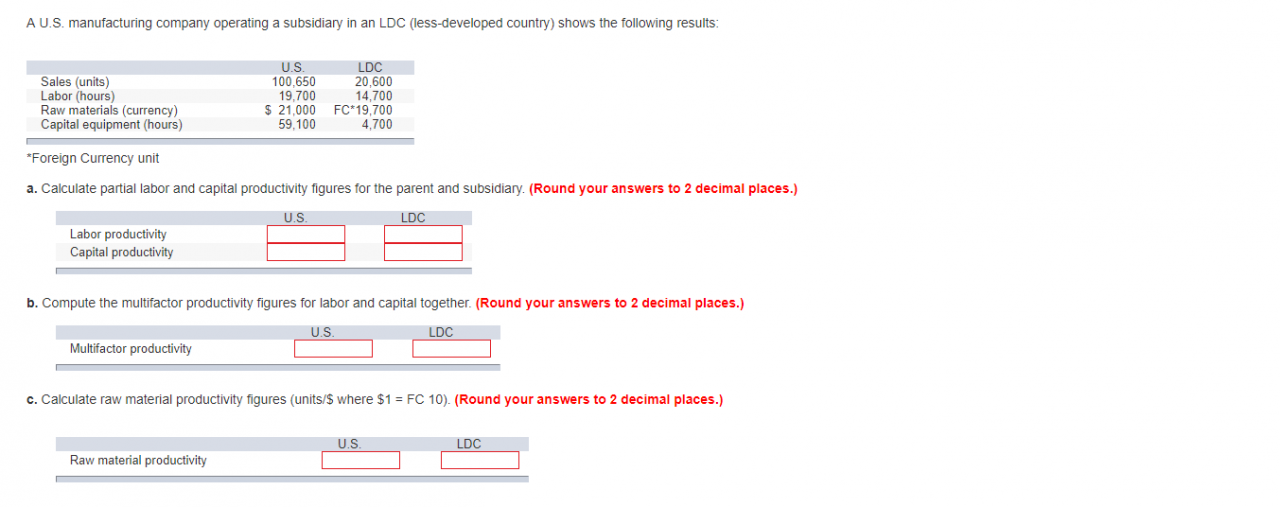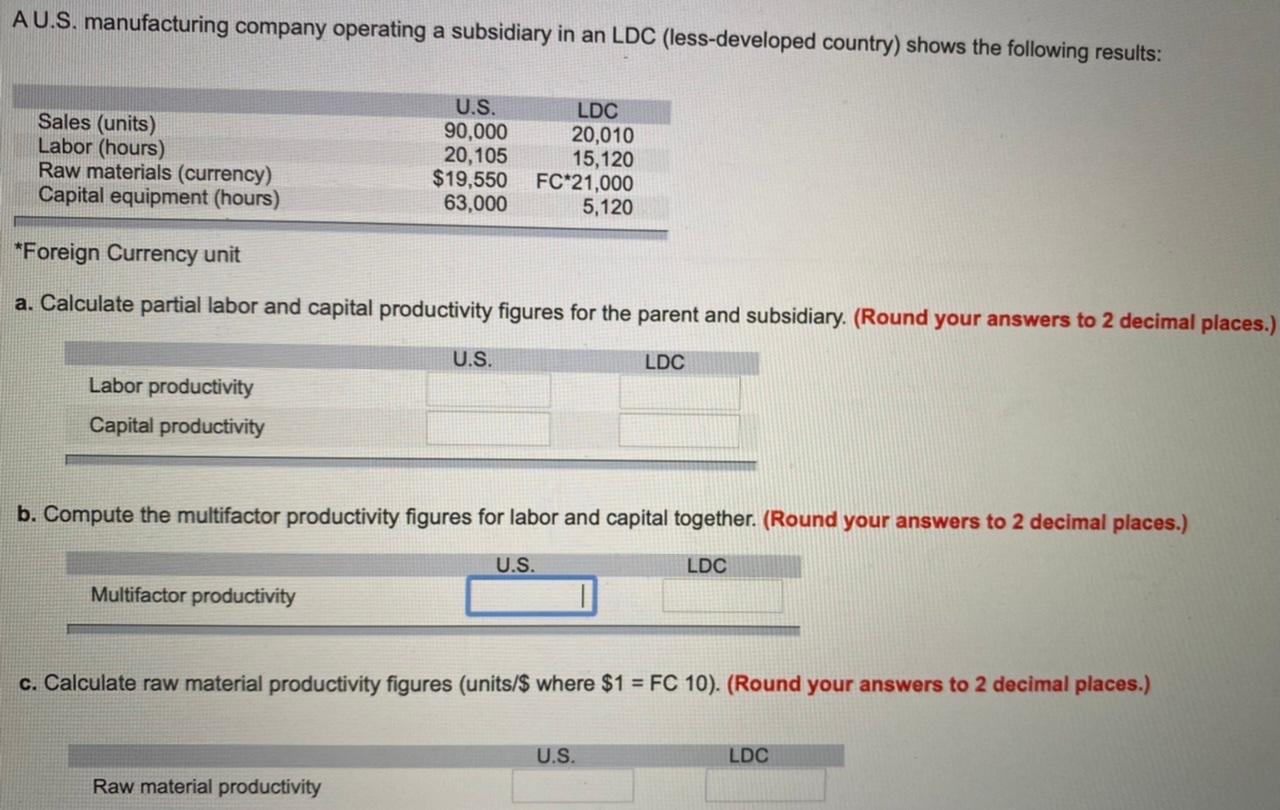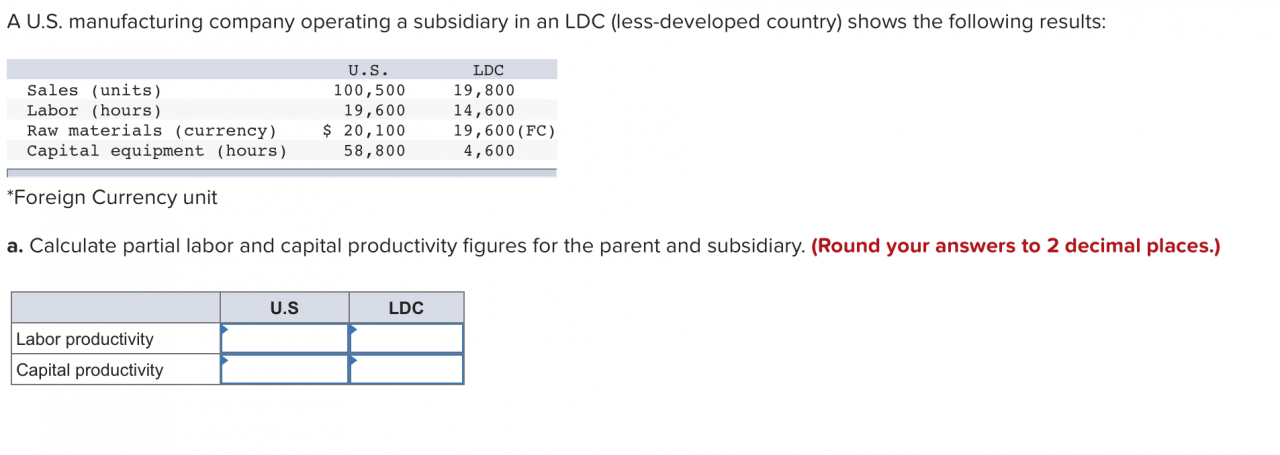A u.s. manufacturing company operating a subsidiary in an ldc – When a U.S. manufacturing company sets up shop in a less developed country (LDC), it’s not just a business move – it’s a catalyst for economic, social, and technological change. From job creation to technology transfer, these partnerships have far-reaching implications for both the company and the host country.
In this exploration, we’ll dive into the multifaceted impact of U.S. manufacturing companies operating subsidiaries in LDCs, examining their contributions to economic growth, job markets, innovation, and more. We’ll also uncover the challenges and opportunities that arise in these dynamic relationships.
Economic Impact
The establishment of the U.S. manufacturing company’s subsidiary in the LDC has had a significant economic impact on the local economy. The company’s operations have created employment opportunities, increased wages, and contributed to the overall standard of living.
Employment
The company’s presence has led to the creation of thousands of new jobs in the LDC. These jobs have provided income and stability for families and have contributed to the growth of the local economy.
Wages
The company has also had a positive impact on wages in the LDC. The company’s presence has increased competition for labor, which has led to higher wages for workers. This has improved the standard of living for many families in the LDC.
Overall Standard of Living
The company’s operations have also contributed to the overall standard of living in the LDC. The company has invested in infrastructure, education, and healthcare, which has benefited the local community. The company has also helped to improve the environment by investing in clean energy and sustainable practices.
Potential Long-Term Economic Benefits and Challenges
The company’s presence in the LDC is expected to have long-term economic benefits for the country. The company’s operations are expected to continue to create jobs, increase wages, and improve the standard of living. However, there are also some potential challenges that the LDC will need to address.
A U.S. manufacturing company operating a subsidiary in an LDC might want to consider the legal implications of recording phone calls, especially if the subsidiary is located in a country with strict privacy laws. For example, in some countries, it is illegal to record a phone call without the consent of both parties.
If you’re unsure about the legality of recording phone calls in the country where your subsidiary is located, you should consult with a local attorney. You can find more information about recording phone calls on an Android phone here . Additionally, you should be aware of the potential risks associated with recording phone calls, such as the possibility of the recording being intercepted or hacked.
These challenges include:
- Ensuring that the company’s operations are sustainable and do not harm the environment.
- Ensuring that the company’s profits are shared equitably with the local community.
- Ensuring that the company’s presence does not lead to economic dependence.
Job Creation and Employment
The U.S. manufacturing company’s operations in the LDC have led to the creation of various job opportunities for the local population. These jobs range from entry-level positions in production and assembly to managerial and technical roles.
The presence of the company has positively impacted the local labor market by providing employment opportunities and improving working conditions. The company offers competitive wages and benefits, adhering to local labor laws and regulations. Moreover, the company invests in employee training and development programs to enhance the skills and knowledge of its workforce.
Employee Training and Development
The company recognizes the importance of investing in its employees’ growth and development. It has established comprehensive training programs to equip employees with the necessary skills and knowledge to perform their jobs effectively. These programs cover various aspects, including technical skills, safety procedures, and quality control measures.
The company also provides opportunities for employees to advance their careers through internal promotions and professional development programs. This commitment to employee development fosters a positive work environment and encourages employees to stay with the company long-term.
A U.S. manufacturing company operating a subsidiary in an LDC may face challenges with communication and collaboration. Fortunately, they can leverage video conferencing tools like Zoom to bridge the gap. To find out if Zoom is compatible with Android devices, you can refer to this helpful guide: can i use zoom on an android . With Zoom’s seamless integration, the manufacturing company can maintain effective communication and collaboration with its subsidiary, fostering a productive work environment.
Technology Transfer and Innovation

The U.S. manufacturing company has played a significant role in transferring technology and knowledge to the LDC. Through its operations in the country, the company has introduced advanced manufacturing techniques, equipment, and processes, which have significantly enhanced the LDC’s industrial development and innovation capacity.
Impact on Industrial Development, A u.s. manufacturing company operating a subsidiary in an ldc
- Enhanced production efficiency and output: The introduction of advanced manufacturing techniques has enabled local industries to improve their productivity, reduce costs, and meet international quality standards.
- Increased access to new technologies: The U.S. manufacturing company has provided training and technical assistance to local engineers and technicians, enabling them to acquire skills in operating and maintaining advanced machinery.
- Expansion of industrial base: The technology transfer has facilitated the establishment of new industries and the diversification of the LDC’s economic base, reducing its reliance on traditional sectors.
Impact on Innovation Capacity
- Stimulation of local R&D: The presence of the U.S. manufacturing company has fostered a culture of innovation within the LDC. Local companies have been inspired to invest in research and development, leading to the creation of new products and processes.
A U.S. manufacturing company operating a subsidiary in an LDC may face challenges related to currency exchange rates and political instability. To mitigate these risks, the company may consider purchasing an asset for 10000 to hedge against potential losses. A company purchases an asset for 10000 can provide stability and protect the company’s investment in the LDC.
By diversifying its portfolio and investing in a tangible asset, the company can reduce its exposure to currency fluctuations and political uncertainty, ensuring the long-term viability of its subsidiary in the LDC.
- Collaboration with local universities: The company has established partnerships with local universities, providing funding for research projects and offering internships to students. This collaboration has strengthened the LDC’s research infrastructure and created a pipeline of skilled professionals.
- Access to global markets: The technology transfer has enabled local companies to produce goods that meet international standards, opening up new export markets and increasing the LDC’s participation in global supply chains.
Potential for Further Technology Transfer
The potential for further technology transfer between the U.S. manufacturing company and the LDC is significant. The LDC has a growing demand for advanced technologies, particularly in sectors such as renewable energy, healthcare, and infrastructure. The U.S. company, with its expertise and resources, is well-positioned to meet this demand and continue to contribute to the LDC’s economic growth and innovation.
Supply Chain Management

The U.S. manufacturing company’s supply chain in the LDC involves a network of suppliers and logistics providers that facilitate the procurement, production, and distribution of goods. The company’s sourcing practices are guided by a commitment to quality, cost-effectiveness, and ethical sourcing.
For instance, a U.S. manufacturing company operating a subsidiary in an LDC might find it challenging to integrate its operations with those of its parent company. To know more about this topic, you can check this out: can i pair my apple watch to an android phone . It’s like trying to pair an Apple Watch with an Android phone – it just doesn’t work.
The two systems are incompatible, and there’s no way to make them work together. The same is true for a U.S. manufacturing company and its LDC subsidiary.
The company collaborates with local suppliers to foster mutually beneficial relationships and promote local economic development.
A U.S. manufacturing company operating a subsidiary in an LDC might find it challenging to integrate its operations with the local workforce. For example, if the subsidiary’s employees are unfamiliar with iTunes, the company may need to provide training on how to use the software.
Can I get my iTunes on an Android ? The answer is yes, but it’s not as simple as just downloading the app from the Google Play Store. You’ll need to use a third-party app like iSyncr or DoubleTwist to transfer your iTunes library to your Android device.
Once you’ve done that, you can access your iTunes music, movies, and TV shows on your Android phone or tablet. However, the company may also need to consider the cultural differences between the two countries and adapt its management style accordingly.
Sourcing Practices and Local Supplier Relationships
The company engages in strategic sourcing practices to identify and qualify local suppliers that meet its quality and sustainability standards. It establishes long-term contracts with reliable suppliers to ensure a stable supply of raw materials, components, and services. The company also provides technical assistance and training to local suppliers to enhance their capabilities and competitiveness.
A U.S. manufacturing company operating a subsidiary in an LDC is constantly facing a plethora of challenges, including labor disputes and currency fluctuations. However, with the advent of technology, accessing critical information from anywhere in the world has become easier than ever before.
Can I access my iCloud from an Android phone ? Yes, you can! This breakthrough allows executives to stay connected with their operations and make informed decisions, even when they are on the go.
By fostering strong relationships with local suppliers, the company contributes to the growth and development of the LDC’s manufacturing sector.
Impact on LDC’s Economy and Local Economic Development
The company’s supply chain has a positive impact on the LDC’s economy. By sourcing from local suppliers, the company creates demand for local products and services, stimulating economic activity. The company also invests in infrastructure and logistics to improve supply chain efficiency, which benefits the entire manufacturing sector in the LDC.
Furthermore, the company’s commitment to ethical sourcing and sustainability promotes responsible business practices and contributes to the long-term development of the LDC’s economy.
Environmental Impact
The U.S. manufacturing company’s operations in the LDC have a significant impact on the environment. The company’s manufacturing processes generate a variety of pollutants, including air emissions, water effluents, and solid waste. The company is also responsible for the consumption of natural resources, such as water and energy.
A U.S. manufacturing company operating a subsidiary in an LDC may face challenges in navigating the local market and legal framework. For instance, the company may encounter difficulties in obtaining necessary permits or complying with labor regulations. If you’re facing a similar issue, you might be wondering can i get truth social on an android phone . The answer is yes, you can download Truth Social on your Android phone through a third-party app store like APKMirror or Aurora Store.
Returning to the topic, a U.S. manufacturing company operating a subsidiary in an LDC should consider carefully the potential risks and rewards before making a decision.
The company’s environmental management practices are designed to minimize its impact on the environment. The company has invested in state-of-the-art pollution control equipment and has implemented a comprehensive environmental management system. The company is also committed to complying with all local environmental regulations.
Potential for Sustainable Development
The company has the potential to contribute to sustainable development in the LDC. The company can create jobs, generate revenue, and improve the quality of life for local communities. The company can also help to transfer environmentally friendly technologies to the LDC.
Social and Cultural Impact
The presence of the U.S. manufacturing company in the LDC has brought about significant social and cultural changes. The company’s policies and practices regarding community engagement and social responsibility have contributed to the overall well-being of the local community.
The company has implemented various initiatives aimed at improving the social and cultural fabric of the LDC. These initiatives include:
Community Engagement
- Establishing community centers that provide educational and recreational programs for local residents.
- Supporting local schools and hospitals through financial assistance and volunteer programs.
- Collaborating with local organizations to address social issues such as poverty, health, and education.
Social Responsibility
- Adopting fair labor practices and ensuring safe working conditions for employees.
- Complying with environmental regulations and implementing sustainable practices.
- Promoting ethical business practices and contributing to the economic development of the LDC.
The company’s commitment to social and cultural development has not only improved the lives of local residents but has also strengthened the company’s reputation and brand image in the LDC. The company’s presence has also contributed to the transfer of knowledge and skills, fostering innovation and entrepreneurship in the local community.
Political and Regulatory Environment
The political and regulatory environment in which the U.S. manufacturing company operates in the LDC is complex and ever-changing. The company must navigate a variety of laws and regulations, including those governing taxation, labor, environmental protection, and intellectual property. The company must also be aware of the political climate in the LDC and the potential for changes in government policy.
The impact of government policies and regulations on the company’s operations and investment decisions can be significant. For example, changes in tax laws can affect the company’s profitability. Changes in labor laws can affect the company’s ability to hire and retain workers.
Changes in environmental regulations can affect the company’s production costs. Changes in intellectual property laws can affect the company’s ability to protect its technology.
Strategies for Navigating the Political and Regulatory Landscape
- The company has developed a number of strategies for navigating the political and regulatory landscape in the LDC. These strategies include:
- Maintaining a close relationship with the government and regulatory agencies.
- Participating in industry associations and lobbying groups.
- Hiring local staff to help the company understand and comply with local laws and regulations.
- Investing in local infrastructure and community development.
- Developing a corporate social responsibility program.
International Trade and Investment: A U.s. Manufacturing Company Operating A Subsidiary In An Ldc

The operations of the U.S. manufacturing company in the LDC have had a significant impact on international trade and investment flows. The company has played a key role in promoting exports from the LDC and attracting foreign direct investment (FDI) to the country.
Exports
The company’s operations in the LDC have led to a significant increase in exports from the country. The company has invested in state-of-the-art manufacturing facilities in the LDC, which has enabled it to produce high-quality goods at competitive prices. These goods are exported to markets around the world, generating foreign exchange earnings for the LDC.
Foreign Direct Investment
The company’s presence in the LDC has also attracted other foreign investors to the country. The company’s success has demonstrated the potential for profitable investment in the LDC, and other companies have followed suit. This has led to an increase in FDI in the LDC, which has helped to create jobs and boost economic growth.
Integration into the Global Economy
The company’s operations in the LDC have also contributed to the country’s integration into the global economy. The company has helped to create a more favorable investment climate in the LDC, and it has also provided training and support to local businesses.
This has helped to create a more competitive and export-oriented economy in the LDC.
Corporate Governance and Transparency
The U.S. manufacturing company has established a robust corporate governance structure and transparency practices in its LDC subsidiary to ensure ethical business operations and compliance with international standards.
The company’s board of directors comprises a diverse group of independent and non-executive members, providing oversight and strategic guidance. The board follows best practices in corporate governance, including regular meetings, clear roles and responsibilities, and adherence to ethical guidelines.
Transparency and Accountability
The company is committed to transparency and accountability in its operations. It publishes annual financial statements, sustainability reports, and other relevant information on its website. The company also undergoes regular independent audits to ensure the accuracy and reliability of its financial reporting.
Compliance with International Standards
The company adheres to international standards, including the Foreign Corrupt Practices Act (FCPA) and the United Nations Global Compact. It has implemented anti-corruption policies and procedures to prevent bribery and other unethical practices.
Promoting Transparency in the LDC
The company plays an active role in promoting transparency and accountability in the LDC. It works with local organizations to raise awareness about good governance practices and supports initiatives to strengthen the rule of law and reduce corruption.
Epilogue
The presence of U.S. manufacturing companies in LDCs is a complex and ever-evolving phenomenon. While these partnerships can bring significant benefits, it’s crucial to navigate the potential challenges and ensure that both parties reap the rewards. By fostering collaboration, transparency, and a commitment to sustainable development, we can harness the power of these cross-border ventures to drive progress and prosperity for all involved.
Questions and Answers
What are the primary economic benefits of U.S. manufacturing companies operating in LDCs?
Increased employment, higher wages, improved standard of living, and potential for long-term economic growth.
How do these companies contribute to job creation in LDCs?
They create a range of jobs, from entry-level to highly skilled, and provide training and development opportunities for local employees.
What are the environmental concerns associated with U.S. manufacturing in LDCs?
Potential for pollution, resource depletion, and waste generation. However, companies are increasingly adopting sustainable practices to minimize their environmental impact.
How do U.S. manufacturing companies navigate the political and regulatory landscape in LDCs?
They engage with local governments, comply with regulations, and develop strategies to manage political risks.